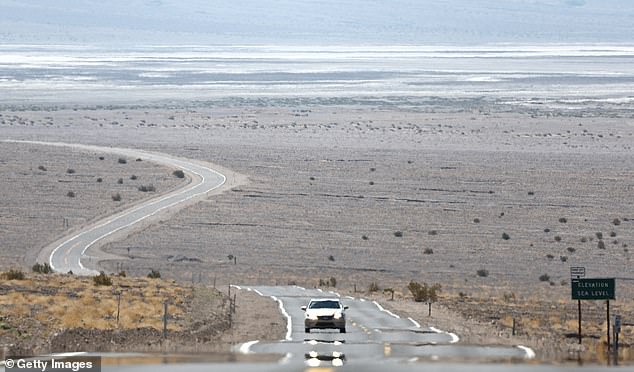Barrage of 130 earthquakes rattle Death Valley as experts fear a big one could be about to hit California
A wave of earthquakes has rocked California’s Death Valley, raising fears that a larger, more devastating quake could be imminent.
According to USGS geophysicist Elizabeth Cochran, 130 earthquakes have struck the National Park since October 9.
The largest occurred on October 25, with magnitudes of 4.7 and 4.5.
The wave of tremors caused no damage to the park or nearby towns and cities, but the tremors can be felt as far as 150 miles away in Las Vegas.
The park’s fault system is known for its intense seismic activity, causing earthquakes up to magnitude 7.
This cluster of earthquakes, considered a ‘swarm’, is not necessarily unusual, but experts have expressed concern that this increase in activity could mean a larger earthquake is on the way.
Since October 9, 130 earthquakes have struck Death Valley. The largest occurred on October 25, with magnitudes 4.7 and 4.5
“That level of shaking is something we’re watching closely because it could have a significant impact on the Las Vegas Valley,” Christie Rowe, director of the Nevada Seismological Lab at the University of Nevada, Reno, told me. KNV Las Vegas.
Activity increased on October 25 when a magnitude 4.2 earthquake struck east of Stovepipe Wells around noon local time.
This was followed by the largest recorded event to date: a magnitude 4.7 earthquake which also struck east of Stovepipe Wells at about 1am.
Another significant event was observed on October 25 at 15:00 UTC, with a M4.5 earthquake occurring 10 km (6.2 mi) southeast of Stovepipe Wells at a depth of 4.6 km (2.9 mi).
Earthquake clusters are common in Nevada, but “they raise our alert levels because sometimes a larger earthquake follows,” Rowe said.
And when one cluster dies out, another usually isn’t far behind, she said, explaining that this pattern of activity usually continues along the California-Nevada border or in central Nevada.
Death Valley has a history of causing major earthquakes.
In 2019, a magnitude 7.1 earthquake struck an area just 30 miles (48 km) away from this current swarm, leaving a deep crack in the ground near Ridgecrest, California, which has since become a local tourist attraction.

Death Valley has a history of causing major earthquakes
A magnitude 6.4 foreshock preceded the mainshock, and these massive earthquakes were followed by 28 earthquakes of magnitude 4.5 or greater, all in the space of five days.
The biggest shock was the largest earthquake to hit the area in two decades.
That’s why Rowe and other experts at the Nevada Seismology Laboratory are keeping a close eye on this swarm and continuing to monitor the region for new activity.
Three major fault lines run through Death Valley: the Northern Death Valley Fault Zone (NDVFZ), the Black Mountains Fault Zone (BMFZ) and the Southern Death Valley Fault Zone (SDVFZ).
These two states have the second and fourth most earthquakes in the US annually.
Earthquake clusters in California often stoke fears of The Big One — a hypothetical high-magnitude earthquake that experts say could strike at any time along the San Andreas Fault.
Such an earthquake would wreak havoc on the state’s famed cities, causing about 1,800 deaths, 50,000 injuries and $200 billion in damage, according to the California Earthquake Authority.
And the San Andreas is long overdue.
But there’s no reason to believe that this recent swarm of earthquakes could cause instability in the San Andreas Fault, or that it could trigger The Big One.
This isn’t the first notable seismic event California has experienced this year.
In early October, the state was rocked by three earthquakes in less than 24 hours.
The largest was a magnitude 3.0 earthquake that struck six kilometers northwest of Walker on October 2 at 12:33 p.m. local time.
This was followed by a magnitude 2.9 earthquake struck 10 miles northeast of Barstow at 10:45 a.m. local time. And at 5:40 p.m., the state suffered another blow when a magnitude 2.6 struck two miles east of Pacheco.
